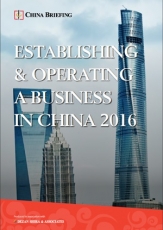China Market Watch: China Reaches Five Year PPI High, and Digitization of Manufacturing Sector
China’s PPI reaches five year high
The National Bureau of Statistics (NBS) released a statement that China’s producer price index (PPI) reached 3.3 percent in November – its highest reading since October 2011, when it recorded five percent. In a separate statement also made by the NBS, the consumer price index (CPI) rose by 2.3 percent in the same month year on year, the third consecutive month in which the index recorded an increase. China’s PPI had been shrinking for 42 consecutive months prior to the spike, which analysts have put down to soaring prices in the coal and steel sectors, as opposed to a rise in domestic demand.
China’s five year plan for digitizing the manufacturing sector
China’s Ministry of Industry and Information Technology and the Ministry (MIIT) of Finance have jointly released a five year plan to digitize the manufacturing sector, develop intelligent manufacturing, and generate new revenue channels. The plan claims that intelligent manufacturing development is key to improving production efficiency, and is also instrumental in reducing production costs and energy consumption. Research and development of such technical equipment will be undertaken in the five year period, setting new standards for the intelligent manufacturing industry, which forms a core part of China’s ‘Made in China 2025’ initiative.
![]() RELATED: Business Advisory Services from Dezan Shira & Associates
RELATED: Business Advisory Services from Dezan Shira & Associates
China further opens clean energy vehicle manufacturing to foreign investment
The National Development and Reform Commission (NDRC) and the Ministry of Commerce (MOFCOM) published a revised guidance to further open up the automotive electronics and new energy vehicles sectors to foreign investment, indicating the government’s intention to re-structure its market environment for clean energy vehicles. Car makers such as Volkswagen, AG, and Mercedes are expanding their production in China, along with introducing new hybrid models to the world’s largest auto market. According to Sinolink Securities Co, the output of lithium-ion automotive batteries in China was 16.9 GWh in 2015, with demand projected to reach 125 GWh in 2020. China’s local governments have also implemented some subsidies to support new energy vehicle companies, but with an increasing number of clean-energy scams, the censorship and supervision for such subsidies is growing stricter.
Google’s first developer conference in Beijing in five years
Google held its first developer conference in Beijing since 2011, five years after a high-profile withdrawal from China, where it failed to comply with policies regarding self censorship of sensitive topics. With the rapid growth of smartphones using Google’s inbuilt Android system in China, the country’s market environment has seen many changes. According to the MIIT, in November 2016, the Android system occupied more than 70 percent of smartphone production. In addition to global giants like Samsung, Chinese smartphones brands, such as Huawei and Xiaomi, also use Android for their operating system. However, the Google Play app store is still banned, and these brands must provide apps with their own online store. The global search giant modified its China strategy after a leadership succession, noting that it never left China and has maintained an existence by offering services through offices overseas.
|
Asia Briefing Ltd. is a subsidiary of Dezan Shira & Associates. Dezan Shira is a specialist foreign direct investment practice, providing corporate establishment, business advisory, tax advisory and compliance, accounting, payroll, due diligence and financial review services to multinationals investing in China, Hong Kong, India, Vietnam, Singapore and the rest of ASEAN. For further information, please email china@dezshira.com or visit www.dezshira.com. Stay up to date with the latest business and investment trends in Asia by subscribing to our complimentary update service featuring news, commentary and regulatory insight.
|

 Establishing & Operating a Business in China 2016
Establishing & Operating a Business in China 2016
Establishing & Operating a Business in China 2016, produced in collaboration with the experts at Dezan Shira & Associates, explores the establishment procedures and related considerations of the Representative Office (RO), and two types of Limited Liability Companies: the Wholly Foreign-owned Enterprise (WFOE) and the Sino-foreign Joint Venture (JV). The guide also includes issues specific to Hong Kong and Singapore holding companies, and details how foreign investors can close a foreign-invested enterprise smoothly in China.
 An Introduction to Doing Business in China 2016
An Introduction to Doing Business in China 2016
Doing Business in China 2016 is designed to introduce the fundamentals of investing in China. Compiled by the professionals at Dezan Shira & Associates in June 2016, this comprehensive guide is ideal not only for businesses looking to enter the Chinese market, but also for companies who already have a presence here and want to keep up-to-date with the most recent and relevant policy changesSelling, Sourcing and E-commerce in China 2016
 China Investment Roadmap: the Food & Beverage Industry
China Investment Roadmap: the Food & Beverage Industry
In this edition of China Briefing, we examine two areas of Chinese food regulations most pertinent for foreign investors today – licensing and certification, and food safety standards. Both have undergone significant change in recent years, altering the way in which foreign companies must engage with the food & beverage industry, and must be thoroughly understood prior to market entry.
- Previous Article Dezan Shira Partners Plan New Asian & Silk Road Development Strategy
- Next Article Preventing Insolvency: How to Plan the Cash Flow and Financing of a WFOE in China





























